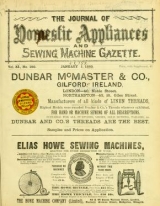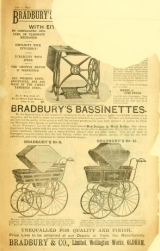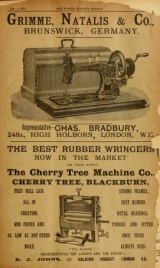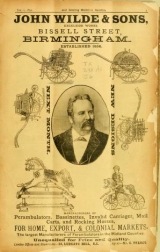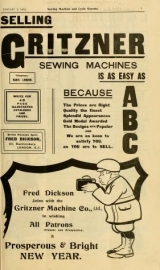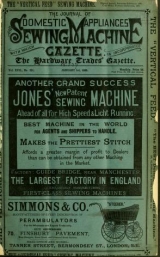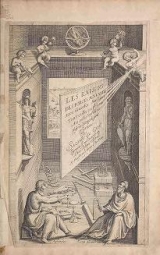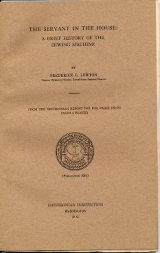Theatrum instrumentorum et machinarum Iacobi Bessoni

This content is in the public domain (free of copyright restrictions). You can copy, modify, and distribute this work without contacting the Smithsonian. For more information, visit the Smithsonian’s Terms of Use page.
NOTE: image 00015, the errata page before the first text is incorrect - it is a duplicated page image of the errata sheet that [correctly] appears at the end of the text. image 00015 should be a diagram.
 Near the end of the 16th century, a new type of book appeared which evolved into an entire genre of literature known as the "Theater of machines." These works represented a new way of thinking that was cultivated during the Renaissance: mathematical principles could be applied to the development of new machines and new technical achievements were appropriate considerations for monarchs and the upper class. Renaissance scholars rediscovered the works of the ancient Greeks and Romans, such as Vitruvius, Frontinus, and Hero of Alexandria, which encouraged men like Villard de Honnecourt and Leonardo da Vinci to experiment with new and ingenious devices. None of Villard's or Leonardo's works were published; they preferred to keep their discoveries to themselves and not reveal their artisan secrets. Eventually, after one hundred years or so, a new group of mathematical practitioners began to appear on the scene, teaching mathematics and producing mathematical instruments. They saw the advantage of applying their mathematical skills to new devices and publicizing them in print so as to attract the attention of patrons and even gain exclusive rights to their inventions. Their Theaters could not help but attract attention as the large books were enhanced by the numerous and often spectacular illustrations that they contained.
Near the end of the 16th century, a new type of book appeared which evolved into an entire genre of literature known as the "Theater of machines." These works represented a new way of thinking that was cultivated during the Renaissance: mathematical principles could be applied to the development of new machines and new technical achievements were appropriate considerations for monarchs and the upper class. Renaissance scholars rediscovered the works of the ancient Greeks and Romans, such as Vitruvius, Frontinus, and Hero of Alexandria, which encouraged men like Villard de Honnecourt and Leonardo da Vinci to experiment with new and ingenious devices. None of Villard's or Leonardo's works were published; they preferred to keep their discoveries to themselves and not reveal their artisan secrets. Eventually, after one hundred years or so, a new group of mathematical practitioners began to appear on the scene, teaching mathematics and producing mathematical instruments. They saw the advantage of applying their mathematical skills to new devices and publicizing them in print so as to attract the attention of patrons and even gain exclusive rights to their inventions. Their Theaters could not help but attract attention as the large books were enhanced by the numerous and often spectacular illustrations that they contained.

The first of the Theaters was produced by Jacques Besson (1540?-1573). Little is known of Besson's life, but a few details have allowed scholars to flesh out what is known of his activities. It is believed that he was born in Grenoble, France, around 1540, but the first historical record of him is from 1557 when he provided the town of Lausanne, Switzerland, with a model of a pump for public fountains. He published a book, De absoluta ratione extrahendi olea et aquas e medicamentis simplicibus [On the complete doctrine of extracting oils and waters from simple drugs] in Zürich in 1559. That same year he moved to Geneva and petitioned to live there as a permanent resident and mathematics teacher. There is some evidence that Besson took up the ministry in 1562 (perhaps under pressure) and became pastor of the Protestant Reformed Church in Villeneuve-de-Berg in France. His ministry did not fare well and he left the town to take up his old occupation of mathematics teacher in Lyon around 1564-65, eventually settling in Orléans by 1567. Here Besson produced his second work, Le Cosmolabe, printed in Paris in 1567. This work, besides describing an elaborate instrument that could be used for navigation, surveying, cartography, and astronomy, contained a preface which listed a number of inventions he hoped he would be able to describe in a future book. This book would become his Theater of Instruments and Machines.

Although illustrations of machines appeared in print before Besson's work (Valturio's De re militari, 1472; Biringuccio's Pirotechnia, 1540; Agricola's De re metallica, 1556), they were merely illustrations of current technology or at best provided limited descriptions of new inventions. Besson was the first to provide a printed work showcasing his mechanical inventions. The opportunity to produce the work came when King Charles IX of France came to Orléans in 1569. Besson presented himself to the King and returned with him to Paris as "master of the King's engines." Charles gave Besson exclusive rights to his designs in that same year and Besson began production of the book which would describe them. The illustrations of the instruments and machines were designed and/or engraved by Jacques Androuet du Cerceau from Besson's specifications. The book appears to have been produced in a hurry as the sixty illustrated machines are not described save for a brief caption in Latin on each engraving. The title page does not note the name of the printer or the date of publication (which was probably in 1571 or 1572). The rush in getting the book to press may have been precipitated by the crackdown on the Protestants (Besson being among them) in France, culminating in the St. Bartholomew's Day Massacre of two thousand Huguenots in Paris in 1572. Even with royal patronage, Besson felt uncomfortable in France and emigrated to England, where he died in 1573.
 Besson's book proved popular enough that a new edition appeared in 1578. This time there were more detailed descriptions of the instruments and machines provided by François Béroalde de Verville. The printer, Barthélemy Vincent, used the copper plates from the original edition, except for plates 17, 35, 39, and 51 for which he substituted new plates by the engraver René Boyvin. The 1578 edition in the Dibner Library collections begins with a new title page which calls the work a "Theater of instruments and machines." The royal privilege and Besson's introduction are then reproduced from the first edition, and these are followed by Béroalde de Verville's descriptions for the sixty plates. Then, after a list of errata, the plates are presented. Besson illustrates a wide variety of instruments and machines. He first starts with six plates of measuring and drawing instruments, many of which were used to produce the original plans for the machines. The plates of the machines follow, and with such a variety that it resembles a veritable theater. There are lathes, stone cutters, saw mills, horse carriages, barrels, dredges, pile drivers, grist mills, hauling machines, cranes, elevators, pumps, salvage machines, nautical propulsion machines, and many others. The work proved a popular success and proceeded through a number of editions in a variety of languages.
Besson's book proved popular enough that a new edition appeared in 1578. This time there were more detailed descriptions of the instruments and machines provided by François Béroalde de Verville. The printer, Barthélemy Vincent, used the copper plates from the original edition, except for plates 17, 35, 39, and 51 for which he substituted new plates by the engraver René Boyvin. The 1578 edition in the Dibner Library collections begins with a new title page which calls the work a "Theater of instruments and machines." The royal privilege and Besson's introduction are then reproduced from the first edition, and these are followed by Béroalde de Verville's descriptions for the sixty plates. Then, after a list of errata, the plates are presented. Besson illustrates a wide variety of instruments and machines. He first starts with six plates of measuring and drawing instruments, many of which were used to produce the original plans for the machines. The plates of the machines follow, and with such a variety that it resembles a veritable theater. There are lathes, stone cutters, saw mills, horse carriages, barrels, dredges, pile drivers, grist mills, hauling machines, cranes, elevators, pumps, salvage machines, nautical propulsion machines, and many others. The work proved a popular success and proceeded through a number of editions in a variety of languages.
Besson's Theater opened the doors for many other theaters of machines, some being quite extensive and lavishly illustrated. Some of the earliest and most notable are listed below in their first edition state along with notes as to which are held by the Smithsonian Institution Libraries (SIL):
- Errard, Jean. Le premier livre des instruments mathématiques méchaniques... Nancy, 1584.
- Ramelli, Agostino. Le diverse et artificiose machine... Paris, 1588 (copy in SIL, along with seven of the original drawings).
- Bachot, Ambroise. Le govvernail... Lequel conduira le curieux de geometrie en perspectiue dedans l'architecture de fortifications, machine de guerre & plusieurs autres particularitez y contenues. Melun, 1598.
- Boillot, Joseph. Modelles, artifices de feu et divers instrumens de guerre avec les moyens de s'en prévaloir... Chaumont-en-Bassigny, 1598.
- Zonca, Vittorio. Novo teatro di machine et edificii per uarie et sicure operationi... Padua, 1607 (copy in SIL).
- Zeising, Heinrich. Theatri machinarvm... Leipzig, 1607-? (copy in SIL, plates only; SIL also has 1708 edition).
- Branca, Giovanni. Le machine... Rome, 1629 (copy in SIL).
- Böckler, Georg Andreas. Theatrum machinarum novum... Nuremberg, 1661 (SIL has 1673 and 1686 editions).
- Grollier de Servière, Gaspard. Recueil d'ouvrages curieux de mathematique et de mecanique... Lyon, 1719 (copy in SIL along with 1751 edition).
The donor
The Smithsonian Institution Libraries' copy of Theatrum instrumentorum et machinarum was part of Bern Dibner's Burndy Library. Bern Dibner (1897-1988) was an electrical engineer, book collector, and philanthropist. Born in the country now known as Ukraine, Dibner immigrated to the United States in 1904 and settled with his family in New York City. He graduated from the Polytechnic Institute of Brooklyn in 1921 and embarked on a career in electrical engineering, which led to his patenting a number of inventions and his founding of the Burndy Engineering Company in 1924. Dibner, who was fascinated by both art and technology, found great pleasure in studying Leonardo da Vinci. This interest led him to obtain a small library (eventually called the Burndy Library) of works about Leonardo which grew over the years as Dibner's interests expanded into the history of electricity, the history of Renaissance technology, and finally the history of science and technology in general. His collection continued to grow, and in 1941 he formally set up the Burndy Library as a separate institution "to advance scholarship in the history of science." By 1964, Dibner's collection totaled over forty thousand volumes and he opened a new building in Norwalk, Connecticut, to house the library more appropriately. In 1974 Bern Dibner donated one-quarter of the Burndy Library's holdings to the Smithsonian Institution to form the nucleus of a research library in the history of science and technology to be located in the young (established 1964) National Museum of History and Technology (now the National Museum of American History). The library opened its doors in 1976 as the Dibner Library of the History of Science and Technology, the first rare book library of the Smithsonian Institution Libraries.
Dibner, who was fascinated by both art and technology, found great pleasure in studying Leonardo da Vinci. This interest led him to obtain a small library (eventually called the Burndy Library) of works about Leonardo which grew over the years as Dibner's interests expanded into the history of electricity, the history of Renaissance technology, and finally the history of science and technology in general. His collection continued to grow, and in 1941 he formally set up the Burndy Library as a separate institution "to advance scholarship in the history of science." By 1964, Dibner's collection totaled over forty thousand volumes and he opened a new building in Norwalk, Connecticut, to house the library more appropriately. In 1974 Bern Dibner donated one-quarter of the Burndy Library's holdings to the Smithsonian Institution to form the nucleus of a research library in the history of science and technology to be located in the young (established 1964) National Museum of History and Technology (now the National Museum of American History). The library opened its doors in 1976 as the Dibner Library of the History of Science and Technology, the first rare book library of the Smithsonian Institution Libraries.
The book
Jacques Besson. Theatrum instrumentorum et machinarum... [Theater of instruments and machines]. Lugduni [Lyon]: Apud Barth. Vincentium [by Barthélemy Vincent], 1578. Twenty-four unnumbered pages, 60 leaves of engraved plates. f TJ144.B55 1578
Cover: Contemporary vellum
Dimensions: 42 x 28.5 cm.
Collation: A-C4
| [A1r] | [1] | Title page |
| [A1v] | [2] | Royal privilege |
| A2r | [3] | Preface to the reader |
| A2v | [4] | Béroalde de Verville's note to the reader |
| [A3r] | [5] | Errata |
| [A3v] - C3v | [6] - [22] | Explanation of the plates |
| [C4r] | [23] | Errata (repeated from page 5 above) |
| [C4v] | [24] | Blank page |
| --- | [Plates] 1-60 | Plates [bound in after page 24] |
Besson's work was first published under the title, Instrumentorum et machinarum... liber primus [Instruments and machines..., the first book]. This work contained no publishing information, but it is believed that the book was printed in Lyon around 1571-1572. The book began with a title-page, dedication to King Charles IX of France, and an address to the reader, all in Latin. This text was followed by a French title-page and dedication followed by a French translation of the Latin text describing the engraved plates (a few of the copies have the French title-page first). A preliminary manuscript version is at the British Library (MS 17921).
This first edition was followed by three editions (with the title changed to Theatrum instrumentorum et machinarum...), all printed in Lyon in 1578. One was a Latin edition, another was in French (Theatre des instrumens mathematiques & mechaniques...), and a third had a Latin and French title page with French text in the preliminary leaves. The Dibner Library copy is the Latin edition. The new editions contained additional text by F. Béroalde de Verville describing the engraved plates in more detail than Besson's brief captions.
Besson's book proved quite popular and went through numerous editions in Latin, French, Italian, Spanish, and German from 1578 to 1602. The Dibner Library, for instance, also has a Latin edition from Lyon, 1582, a German edition from Montbéliard, 1595, and a French edition from Lyon, 1596. Interestingly enough, no English edition was ever produced although the work was well-known in Great Britain.
Sources
On Besson and "Theaters of Machines"
- Hillard, Denise. "Jacques Besson et son Théâtre des instrumens mathématiques," in Revue française de l'Histoire du Livre 22 (1979): 5-38 and 30 (1981): 47-69.
- Keller, Alexander Gustav. A Theatre of Machines. New York: The Macmillan Company, 1965.
- ______. "The Missing Years of Jacques Besson, Inventor of Machines, Teacher of Mathematics, Distiller of Oils, and Huguenot Pastor," in Technology and Culture 14 (1973): 28-39.
- ______. "A Manuscript Version of Jacques Besson's Book of Machines, With His Unpublished Principles of Mechanics," in On Pre-Modern Technology and Science, edited by Bert S. Hall and Delno C. West. Malibu, CA: Undena Publications, 1976.
On the book
- Christie's New York. The Haskell F. Norman Library of Science and Medicine. Part I: The Middle Ages and Renaissance. Auction catalogue for sale 8854, Wednesday, 18 March 1998, pp. 54-55. New York: Christie's, Inc., 1998.
- Harvard College Library Department of Printing and Graphic Arts catalogue of books and manuscripts. Part I: French 16th century books. Compiled by Ruth Mortimer under the supervision of Philip Hofer and William A. Jackson, pp. 76-80. Cambridge, Massachusetts: Belknap Press of Harvard University Press, 1964.
- Hook, Diana H. and Jeremy M. Norman. The Haskell F. Norman Library of Science and Medicine, vol. 1, pp. 83-84. San Francisco: Jeremy Norman & Co., Inc., 1991.
- Nigel Phillips Antiquarian Books. Catalogue 23, pp. 4-5. [London: Nigel Phillips, 1999].
Ronald Brashear
Curator of Science and Technology Rare Books
Special Collections Department
Smithsonian Institution Libraries
September 1999
APA Citation
Besson, Jacques, Dauphinois. (1578). Theatrum instrumentorum et machinarum Iacobi Bessoni. Apud Barth. Vincentium. Retrieved from https://doi.org/10.5479/sil.269182.39088000339796
MLA Citation
Besson, Jacques, Dauphinois. Theatrum instrumentorum et machinarum Iacobi Bessoni. Apud Barth. Vincentium, 1578, https://doi.org/10.5479/sil.269182.39088000339796
Chicago
Besson, Jacques, Dauphinois. Theatrum instrumentorum et machinarum Iacobi Bessoni. Apud Barth. Vincentium, 1578. doi: https://doi.org/10.5479/sil.269182.39088000339796

|
Add this page to your Mendeley Library |

|
Get Zotero Plugin |



